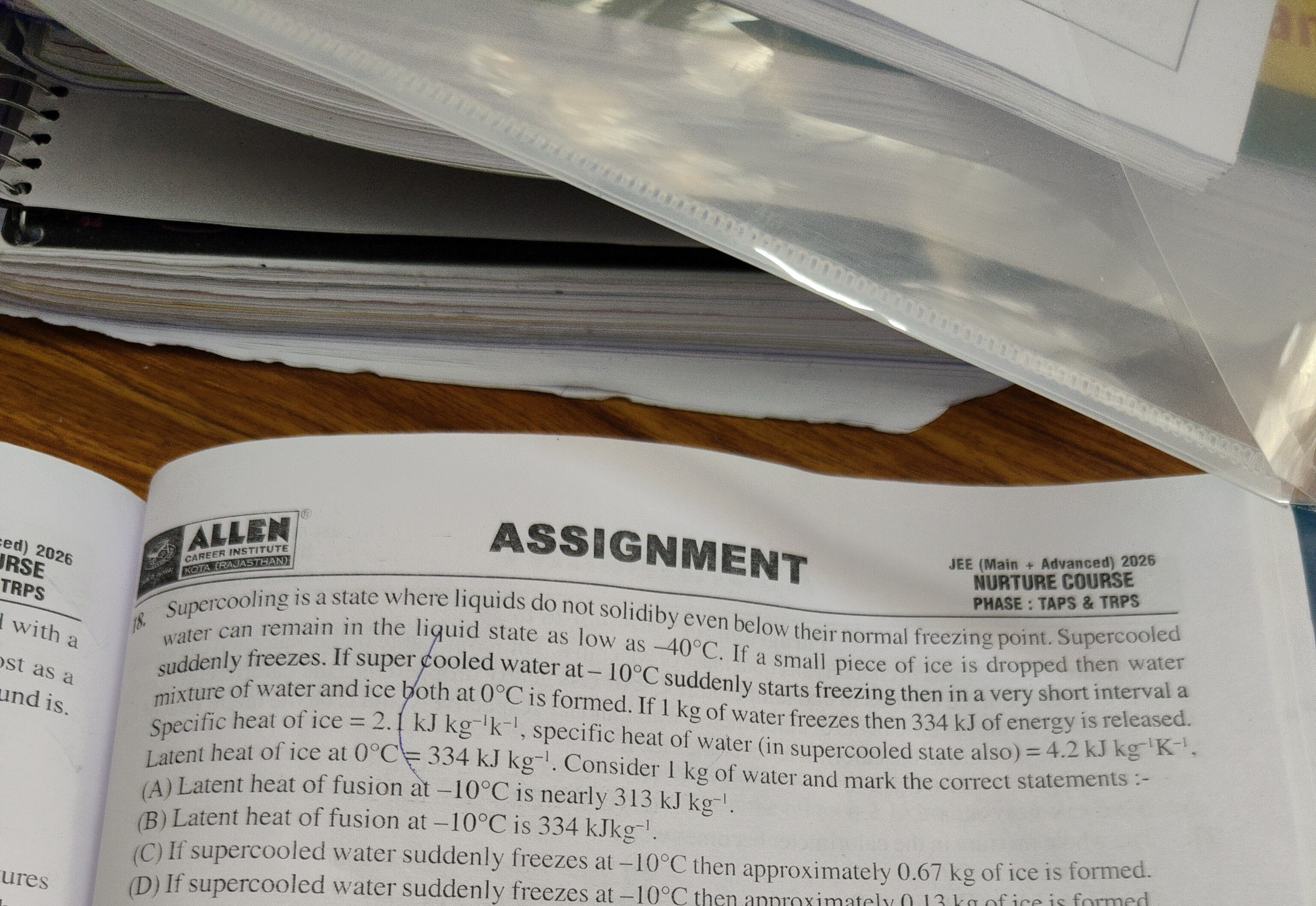Question
Question: Supercooling is a state where liquids do not solidiby even below their normal freezing point. Superc...
Supercooling is a state where liquids do not solidiby even below their normal freezing point. Supercooled water can remain in the liquid state as low as -40°C. If a small piece of ice is dropped then water suddenly freezes. If super cooled water at -10°C suddenly starts freezing then in a very short interval a mixture of water and ice both at 0°C is formed. If 1 kg of water freezes then 334 kJ of energy is released. Specific heat of ice = 2.1 kJ kg−1k−1, specific heat of water (in supercooled state also) = 4.2 kJ kg−1K−1, Latent heat of ice at 0°C = 334 kJ kg−1. Consider 1 kg of water and mark the correct statements :-

Latent heat of fusion at -10°C is nearly 313 kJ kg−1.
Latent heat of fusion at -10°C is 334 kJkg−1.
If supercooled water suddenly freezes at -10°C then approximately 0.67 kg of ice is formed.
If supercooled water suddenly freezes at -10°C then approximately 0.13 kg of ice is formed.
A, D
Solution
The latent heat of fusion (Lf) can be approximated as a function of temperature using the specific heats of the liquid (cliquid) and solid (csolid) phases: Lf(T)=Lf(T0)+∫T0T(cliquid−csolid)dT
Statement (A): Latent heat of fusion at -10°C is nearly 313 kJ kg−1. Given Lf(0∘C)=334 kJ/kg, cwater=4.2 kJ kg−1K−1, and cice=2.1 kJ kg−1K−1. Let T0=0∘C and T=−10∘C. Lf(−10∘C)=Lf(0∘C)+(cwater−cice)×(T−T0) Lf(−10∘C)=334 kJ/kg+(4.2−2.1) kJ kg−1K−1×(−10−0) K Lf(−10∘C)=334+(2.1)×(−10)=334−21=313 kJ kg−1. Thus, statement (A) is correct.
Statement (B): Latent heat of fusion at -10°C is 334 kJkg−1. As calculated above, the latent heat of fusion at -10°C is approximately 313 kJ kg−1, not 334 kJ kg−1 (which is the value at 0°C). Thus, statement (B) is incorrect.
Statements (C) and (D): If supercooled water suddenly freezes at -10°C then approximately 0.67 kg of ice is formed or approximately 0.13 kg of ice is formed. When supercooled water at -10°C suddenly freezes, it releases energy. This energy causes the temperature of the remaining water to rise to 0°C, and then the phase change (freezing) occurs at 0°C, resulting in a mixture of ice and water at 0°C. Let mice be the mass of ice formed. The remaining mass of water is (1−mice) kg. The energy released by freezing mice kg of water at 0°C is Qreleased=mice×Lf=mice×334 kJ. This energy is absorbed by the (1−mice) kg of water to heat it from -10°C to 0°C: Qabsorbed=(1−mice)×cwater×ΔT=(1−mice)×4.2 kJ kg−1K−1×(0−(−10)) K Qabsorbed=(1−mice)×4.2×10=(1−mice)×42 kJ. Equating the energy released and absorbed: mice×334=(1−mice)×42 334mice=42−42mice 376mice=42 mice=37642≈0.1117 kg. This value is approximately 0.13 kg. Thus, statement (D) is correct. Statement (C) is incorrect as 0.67 kg is not close to 0.1117 kg.
